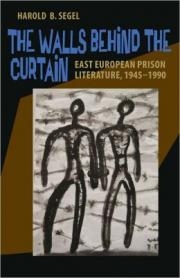The Walls Behind the Curtain
Edited by Harold B. Segel
University of Pittsburgh Press
The prison systems of all democracies are alike; every dictatorship has its own way of torturing its prisoners. The Russians, whether in the days of the tsars or in communist times, sent their victims to freezing Siberia, a natural prison by itself, where the underfed prisoners did hard labor until they dropped dead. The Ugandan dictator Idi Amin simply fed his prisoners to the crocodiles, the Taliban organize mutilations and stonings for their victims, and so on.
This fascinating book, edited by Prof. Harold B. Segel of Columbia University, presents a rich sampling of writings by people imprisoned in the jails of the former Eastern European Soviet colonies, or Soviet satellites, to use the time-honored euphemism. Who were these prisoners? You might guess they were people associated with the regimes deposed by the communists, or people who dared to oppose the communist system, or writers whose writings had offended the government. You could even guess that they were people guilty of absolutely nothing. With each of these guesses you would be right in quite a few cases, but the general picture is much weirder than that. It is not as if all Soviet satellites had been nice democracies overrun by the evil commies. Quite a few of these countries were fascist dictatorships, as evil as what came after them. Therefore, to hear, for example, Nichifor Crainic, a poet and also the minister of propaganda in Marshal Ion Antonescu’s wartime Romanian fascist dictatorship, kvetch poetically about how he was hungry in communist prison, calls forth not compassion but rather a paradox. Should one’s natural disgust at the communist methods of torture be trumped by one’s equally natural Schadenfreude, prompting a smile and and a “Serves him right”? Unlike the victims of the atrocities committed by the Antonescu regime, Nichifor Crainic managed to survive the hardships of his communist imprisonment and then managed to find employment as editor of, wouldn’t you know, a communist propaganda magazine.
Segel provides a brief and informative biography for each of the authors included in this collection. For Nichifor Crainic he accurately describes the man’s life story, but he abstains from passing any judgment and lets the reader discover the moral discrepancy between what this man said and what he did. This intensifies the effect of Crainic’s inclusion, which on literary merit alone would hardly be justified.
If I start with Crainic, a Romanian writer, it is because (full disclosure!) I myself was born and grew up in Romania, so not surprisingly, I first took a look at the Romanian writers in this volume. This was easy, as the volume is organized by the writers’ nationality.
At this point I should mention that the texts incorporated in this book are almost all translated by Segel himself from seven languages into English, a real tour de force. But what is the purpose of this collection? On the one hand, there is a historic purpose for using the voices of the victims to expose atrocities committed by communist governments and the way people dealt with the horrors inflicted upon them. The other purpose is literary. After all, prison writing has a spectacular record in European literature. Think of Miguel de Cervantes, Alexander Sergeyevich Pushkin, Fyodor Mikhailovich Dostoyevsky, Charles Dickens (who wrote about not his own but his father’s prison experiences), Oscar Wilde, Louis Ferdinand Céline, and Jean Gênet, to name but a few. Wilde summed it up in one of his famous quips: “If this is the way Queen Victoria treats her prisoners, she doesn’t deserve to have any.” By such standards none of the rulers of the Soviet satellite states ever “deserved” to have any prisoners, but with Generalissimo Josef Stalin as their sponsor, they got them anyway, and this book acquaints us with their writings.
Of the great European writers I just listed, only Céline and the two Russians were political prisoners. The practice of imprisoning writers for political reasons can be traced at least as far back as the great Roman poet Ovid, exiled on a whim by the emperor Augustus to Tomis, the current Constanţa in Romania.
Segel’s choice of writers is very interesting. We find well-known dissidents who had played an important historic role, such as the Czech Václav Havel, the Pole Adam Michnik, the Montenegrin Milovan Djilas. Much as one may admire their indisputable courage and political insights, their artistic merit is on a much less solid footing. Consider the excerpt from Adam Michnik’s Letters from Prison and Other Essays. Starting from the outrageously slanderous propaganda injected by the communist authorities into the internationally reported-upon trial of the murderers of Rev. Yerzy Popieluszko, Michnik discusses the role of the Catholic Church in Polish history. His historically and politically well-informed analysis of this interesting issue is constructed as what can best be described as an op-ed article. By all accounts, Michnik was the brilliant idea man of the Polish Solidarity movement, and reading his take on major events of those days is unquestionably of historic interest. But historic interest and literary value are two different things.
In the Romanian section, right after Crainic, we find the poet Radu Gyr, tainted by his very active membership in the ultra-fascist Iron Guard. Similar stains also burden some of the writers mentioned in Segel’s introduction but not included in the collection, such as the Bulgarian novelist Fani Popova-Mutafova. The Romanian section also features Paul Goma, the dissident writer forced by the communist government to emigrate to France, only to be pursued in Paris by an assassin sent by have the Ceauşescu regime. It made worldwide headlines at the time, because the assassin defected to the French counterintelligence. In an excerpt from his novel Gherla, Goma records his memories of his stay at the ferocious Gherla prison.
Like Goma, many of the writers detail, mostly in memoir form, the banal ways in which they were harassed and tortured. As the Macedo-Bulgarian Venko Markovski puts it so well, “Everything is forbidden us at Goli Otok. . . . Even sighing is forbidden us.” Goli Otok is an Adriatic island-prison that makes Alcatraz look like picnic grounds. Officially labeled “a program of reeducation,” this program of torture had in many cases the clear goal of recruiting the prisoner as an informer.
In the Hungarian contingent we find Tibor Déry represented, among some other of his writings, by an excerpt from his novel Liebe Mamuskám!, written in that marvelous German- Hungarian hybrid developed in the days of the Austro-Hungarian kaiserlich und königlich, or k.u.k., empire (the title of the novel means “My dear Mommy” with the word dear in German and the rest in idiomatic Hungarian). It is constructed with letters from Déry to his mother, written in prison and then conveyed through a long chain of friends and mailed to her from the West, so as to hide from the unsuspecting mother the fact that her son is languishing in a communist prison. This caught my attention because the novel Liebe Mamuskám! provides the basis for the magnificent Hungarian film Szerelem (Love), starring the legendary actress Lili Darvas, widow of the famous writer Franz Molnar. Molnar himself had a big political problem: both he and his wife were Jews in fascist Hungary. The way they dealt with this was by emigrating to the United States. Notice the difference from Paul Goma or Aleksandr Solzhenitsyn, who were forced by their countries’ governments to emigrate, though the end result, exile, was the same.
Beyond the hardships of imprisonment, for a writer a maybe even more painful fate is exile to a foreign land in which his or her mother tongue is not spoken. Such exile can affect painters (e.g., Pablo Picasso and Marc Chagall) and composers (e.g., Béla Bartók and Arnold Schoenberg) as well, but in exile you can paint just as in your native land, and music sounds just about the same everywhere. By contrast, exile deprives a writer of exposure to the language that is her or his medium. The street signs are in a foreign language, the people on the bus speak that language as well, and so the writer cannot overhear conversations and then use snippets of them in writing. All this notwithstanding, some great poets and writers have managed to write major works in their mother tongue while in exile: Polish poet Czesław Miłosz, Czech novelist Milan Kundera, Irish novelist James Joyce (who wrote in a rich language of his very own, to which continued exposure to the sounds of Dublin streets might have added very little). Other writers “adapt” to exile by changing the language in which they write: Joseph Conrad, Eugène Ionesco. Yet others write in both itheir mother tongue and the language of their land of exile: Vladimir Nabokov, Samuel Beckett. An ironic twist on all this is provided by the novelist Herta Müller, whose mother tongue is German even though she was born in Romania, and who, after growing up in Romania and graduating from the West University of Timişoara, was allowed to leave Romania for Germany, where she writes in German. Anyone familiar with the work of these artists cannot fail to notice the superlative quality of their writing in exile. Why are exiled writers able to write so well? Is it because they have a picture of things on a grander scale? Or is it because they are not exposed to physical pain and deprivation or to deep-seated and continuous fear, as they would be in a prison in their homeland? I do not know the answers to these questions. It would be really nice if Segel could follow up this excellent book on cold war East European prison literature by editing a book on cold war East European exile literature.



